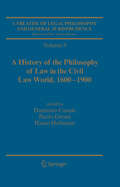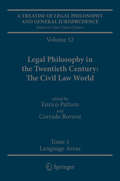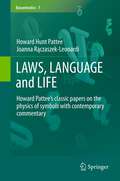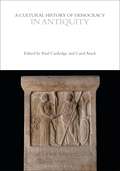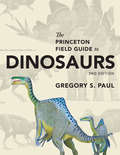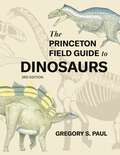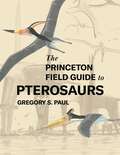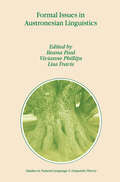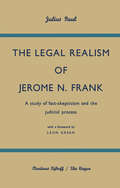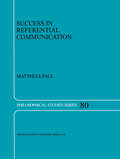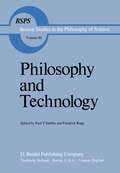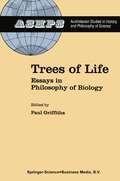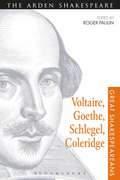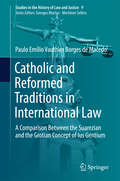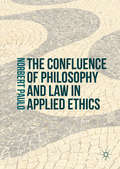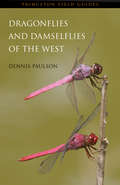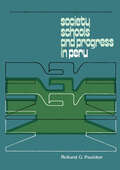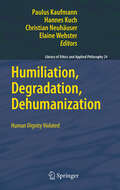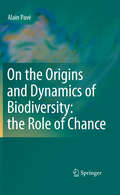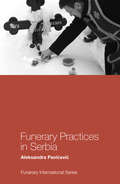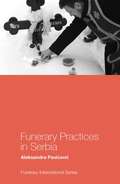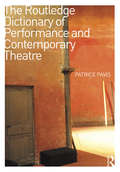- Table View
- List View
A Treatise of Legal Philosophy and General Jurisprudence: Vol. 9: A History of the Philosophy of Law in the Civil Law World, 1600-1900; Vol. 10: The Philosophers' Philosophy of Law from the Seventeenth Century to Our Days.
by Enrico PattaroTO VOLUMES 9 AND 10 OF THE TREATISE I am happy to present here the third batch of volumes for the Treatise project: This is the batch consisting of Volumes 9 and 10, namely, A History of the P- losophy of Law in the Civil Law World, 1600–1900, edited by Damiano Canale, Paolo Grossi, and Hasso Hofmann, and The Philosophers’ Philosophy of Law from the Seventeenth Century to Our Days, by Patrick Riley. Three v- umes will follow: Two are devoted to the philosophy of law in the 20th c- tury, and the third one will be the index for the entire Treatise, which will 1 therefore ultimately comprise thirteen volumes. This Volume 9 runs parallel to Volume 8, A History of the Philosophy of Law in the Common Law World, 1600–1900, by Michael Lobban, published in 2007. Volume 10, for its part, takes up where Volume 6 left off: which appeared under the title A History of the Philosophy of Law from the Ancient Greeks to the Scholastics (edited by Fred Miller Jr. in association with Carrie-Ann Biondi, likewise published in 2007), and which is mainly a history of the p- losophers’ philosophy of law (let us refer to this philosophy as A).
A Treatise of Legal Philosophy and General Jurisprudence: Volume 12 Legal Philosophy in the Twentieth Century: The Civil Law World, Tome 1: Language Areas, Tome 2: Main Orientations and Topics
by Enrico Pattaro Corrado RoversiA Treatise of Legal Philosophy and General Jurisprudence is the first-ever multivolume treatment of the issues in legal philosophy and general jurisprudence, from both a theoretical and a historical perspective. The work is aimed at jurists as well as legal and practical philosophers. Edited by the renowned theorist Enrico Pattaro and his team, this book is a classical reference work that would be of great interest to legal and practical philosophers as well as to jurists and legal scholar at all levels. The work is divided in two parts. The theoretical part (published in 2005), consisting of five volumes, covers the main topics of the contemporary debate; the historical part, consisting of six volumes (Volumes 6-8 published in 2007; Volumes 9 and 10, published in 2009; Volume 11 published in 2011 and Volume 12 forthcoming in 2016), accounts for the development of legal thought from ancient Greek times through the twentieth century. Volume 12 Legal Philosophy in the Twentieth Century: The Civil Law WorldVolume 12 of A Treatise of Legal Philosophy and General Jurisprudence, titled Legal Philosophy in the Twentieth Century: The Civil-Law World, functions as a complement to Gerald Postema’s volume 11 (titled Legal Philosophy in the Twentieth Century: The Common Law World), and it offers the first comprehensive account of the complex development that legal philosophy has undergone in continental Europe and Latin America since 1900. In this volume, leading international scholars from the different language areas making up the civil-law world give an account of the way legal philosophy has evolved in these areas in the 20th century, the outcome being an overall mosaic of civil-law legal philosophy in this arc of time. Further, specialists in the field describe the development that legal philosophy has undergone in the 20th century by focusing on three of its main subjects—namely, legal positivism, natural-law theory, and the theory of legal reasoning—and discussing the different conceptions that have been put forward under these labels. The layout of the volume is meant to frame historical analysis with a view to the contemporary theoretical debate, thus completing the Treatise in keeping with its overall methodological aim, namely, that of combining history and theory as a necessary means by which to provide a comprehensive account of jurisprudential thinking.
LAWS, LANGUAGE and LIFE: Howard Pattee’s classic papers on the physics of symbols with contemporary commentary (Biosemiotics #7)
by Howard Hunt Pattee Joanna Rączaszek-LeonardiHoward Pattee is a physicist who for many years has taken his own path in studying the physics of symbols, which is now a foundation for biosemiotics. By extending von Neumann’s logical requirements for self-replication, to the physical requirements of symbolic instruction at the molecular level, he concludes that a form of quantum measurement is necessary for life. He explains why all non-dynamic symbolic and informational controls act as special (allosteric) constraints on dynamical systems. Pattee also points out that symbols do not exist in isolation but in coordinated symbol systems we call languages. Such insights turn out to be necessary to situate biosemiotics as an objective scientific endeavor. By proposing a way to relate quiescent symbolic constraints to dynamics, Pattee’s work builds a bridge between physical, biological, and psychological models that are based on dynamical systems theory. Pattee’s work awakes new interest in cognitive scientists, where his recognition of the necessary separation—the epistemic cut—between the subject and object provides a basis for a complementary third way of relating the purely symbolic, computational models of cognition and the purely dynamic, non-representational models. This selection of Pattee’s papers also addresses several other fields, including hierarchy theory, artificial life, self-organization, complexity theory, and the complementary epistemologies of the physical and biological sciences.
A Cultural History of Democracy in Antiquity (The Cultural Histories Series)
by Paul Cartledge and Carol AtackThis volume surveys democracy broadly as a cultural phenomenon operating in different ways across a very wide range of ancient societies throughout Antiquity. It examines the experiences of those living in democratic communities and considers how ancient practices of democracy differ from our own.The origins of democracy can be traced in a general way to the earliest civilizations, beginning with the early urban societies of the Middle East, and can be seen in cities and communities across the Mediterranean world and Asia. In classical Athens, male citizens enjoyed full participation in the political life of the city and a flourishing democratic culture, as explored in detail in this volume. In other times and places democratic features were absent from the formal structures of regimes, but could still be found in the participatory structures of local social institutions.Each chapter takes a different theme as its focus: sovereignty; liberty and the rule of law; the “common good”; economic and social democracy; religion and the principles of political obligation; citizenship and gender; ethnicity, race, and nationalism; democratic crises, revolutions, and civil resistance; international relations; and beyond the polis. These ten different approaches to democracy in Antiquity add up to an extensive, synoptic coverage of the subject.
Vagueness and Language Use (Palgrave Studies in Pragmatics, Language and Cognition)
by Paul Égré & Nathan KlinedinstThis volume brings together twelve papers by linguists and philosophers contributing novel empirical and formal considerations to theorizing about vagueness. Three main issues are addressed: gradable expressions and comparison, the semantics of degree adverbs and intensifiers (such as 'clearly'), and ways of evading the sorites paradox.
The Princeton Field Guide to Dinosaurs: Second Edition
by Gregory S. PaulThe best-selling Princeton Field Guide to Dinosaurs remains the must-have book for anyone who loves dinosaurs, from amateur enthusiasts to professional paleontologists. Now extensively revised and expanded, this dazzlingly illustrated large-format edition features some 100 new dinosaur species and 200 new and updated illustrations, bringing readers up to the minute on the latest discoveries and research that are radically transforming what we know about dinosaurs and their world.Written and illustrated by acclaimed dinosaur expert Gregory Paul, this stunningly beautiful book includes detailed species accounts of all the major dinosaur groups as well as nearly 700 color and black-and-white images—skeletal drawings, "life" studies, scenic views, and other illustrations that depict the full range of dinosaurs, from small feathered creatures to whale-sized supersauropods. Paul's extensively revised introduction delves into dinosaur history and biology, the extinction of nonavian dinosaurs, the origin of birds, and the history of dinosaur paleontology, as well as giving a taste of what it might be like to travel back in time to the era when dinosaurs roamed the earth.Now extensively revised and expandedCovers nearly 750 dinosaur species, including scores of newly discovered onesProvides startling new perspectives on the famed Brontosaurus and TyrannosaurusFeatures nearly 700 color and black-and-white drawings and figures, including life studies, scenic views, and skull and muscle drawingsIncludes color paleo-distribution maps and a color time lineDescribes anatomy, physiology, locomotion, reproduction, and growth of dinosaurs, as well as the origin of birds and the extinction of nonavian dinosaurs
The Princeton Field Guide to Dinosaurs Third Edition (Princeton Field Guides #69)
by Gregory S. PaulA fully updated and expanded edition of the acclaimed, bestselling dinosaur field guideThe bestselling Princeton Field Guide to Dinosaurs remains the must-have book for anyone who loves dinosaurs, from amateur enthusiasts to professional paleontologists. Now extensively revised and expanded, this dazzlingly illustrated large-format edition features nearly 100 new dinosaur species and hundreds of new and updated illustrations, bringing readers up to the minute on the latest discoveries and research that are radically transforming what we know about dinosaurs and their world.Written and illustrated by acclaimed dinosaur expert Gregory Paul, this stunningly beautiful book includes detailed species accounts of all the major dinosaur groups as well as a wealth of breathtaking images—skeletal drawings, &“life&” studies, scenic views, and other illustrations that depict the full range of dinosaurs, from small feathered creatures to whale-sized supersauropods. Paul&’s extensive introduction delves into dinosaur history and biology, the extinction of nonavian dinosaurs, the origin of birds, and the history of dinosaur paleontology, and also gives a taste of what it might be like to travel back in time to the era when dinosaurs roamed the earth.Now covers more than 800 dinosaur species, including scores of newly discovered onesProvides startling perspectives on the famed Brontosaurus and TyrannosaurusReveals that the largest dinosaurs weighed as much as the biggest whales, and shows why that happenedFeatures hundreds of color and black-and-white drawings and figures, including life studies, scenic views, and skull and muscle drawingsIncludes color paleo-distribution maps and a color time lineDescribes anatomy, physiology, locomotion, reproduction, and growth of dinosaurs, as well as the origin of birds and the extinction of nonavian dinosaurs
The Princeton Field Guide to Pterosaurs (Princeton Field Guides #155)
by Gregory S. PaulThe most up-to-date and authoritative illustrated guide to the marvelous flying reptiles that dominated the skies of the Mesozoic for 160 million yearsOnce seen by some as evolutionary dead-enders, pterosaurs were vigorous winged reptiles capable of thriving in an array of habitats and climates, including polar winters. The Princeton Field Guide to Pterosaurs transforms our understanding of these great Mesozoic archosaurs of the air. This incredible guide covers 115 pterosaur species and features stunning illustrations of pterosaurs ranging in size from swallows to small sailplanes, some with enormous, bizarre head crests and elongated beaks. It discusses the history of pterosaurs through 160 million years of the Mesozoic—including their anatomy, physiology, locomotion, reproduction, growth, and extinction—and even gives a taste of what it might be like to travel back to the Mesozoic. This one-of-a-kind guide also challenges the common image of big pterosaurs as ultralights that only soared, showing how these spectacular creatures could be powerful flappers as heavy as bears.Features detailed species accounts of 115 different kinds of pterosaurs, with the latest size and mass estimatesWritten and illustrated by the acclaimed researcher and artist who helped to redefine the anatomy and flight performance of pterosaursCovers everything from pterosaur biology to the colorful history of pterosaur paleontologyIncludes dozens of original skeletal drawings and full-color life studies
Formal Issues in Austronesian Linguistics (Studies in Natural Language and Linguistic Theory #49)
by I. Paul V. Phillips Lisa TravisAustronesian languages have long raised interesting questions for generative theories of syntax and morphology. The papers in this volume encompass some of these traditional questions and place them in newer theoretical contexts. Some of the papers also address new issues which add to our understanding of members of this language family on one side and the nature of linguistic theories on the other. There are three broad issues that re-occur throughout the volume - the role and analysis of verbal morphology, the nature of the subject or the topic in these languages, and the interaction of syntax and specificity. The papers in this volume show that as formal theories become more precise, a wider range of language data can be captured, and as the inventory of language data grows, the accuracy of formal linguistic theories improves.
The Legal Realism of Jerome N. Frank: A Study of Fact-Skepticism and the Judicial Process
by Julius PaulBetween the Levite at the gate and the judicial systems of our day is a long journey in courthouse government, but its basic structure remains the same - law, judge and process. Of the three, process is the most unstable - procedure and facts. Of the two, facts are the most intractable. While most of the law in books may seem to center about abstract theories, doctrines, princi ples, and rules, the truth is that most of it is designed in some way to escape the painful examination of the facts which bring parties in a particular case to court. Frequently the emphasis is on the rule of law as it is with respect to the negotiable instru ment which forbids inquiry behind its face; sometimes the empha sis is on men as in the case of the wide discretion given a judge or administrator; sometimes on the process, as in pleading to a refined issue, summary judgment, pre-trial conference, or jury trial designed to impose the dirty work of fact finding on laymen. The minds of the men of law never cease to labor at im proving process in the hope that some less painful, more trustworthy and if possible automatic method can be found to lay open or force litigants to disclose what lies inside their quarrel, so that law can be administered with dispatch and de cisiveness in the hope that truth and justice will be served.
Success in Referential Communication (Philosophical Studies Series #80)
by M. PaulOne of the most basic themes in the philosophy of language is referential uptake, viz., the question of what counts as properly `understanding' a referring act in communication. In this inquiry, the particular line pursued goes back to Strawson's work on re-identification, but the immediate influence is that of Gareth Evans. It is argued that traditional and recent proposals fail to account for success in referential communication. A novel account is developed, resembling Evans' account in combining an external success condition with a Fregean one. But, in contrast to Evans, greater emphasis is placed on the action-enabling side of communication. Further topics discussed include the role of mental states in accounting for communication, the impact of re-identification on the understanding of referring acts, and Donnellan's referential/attributive distinction. Readership: Philosophers, cognitive scientists and semanticists.
Philosophy and Technology (Boston Studies in the Philosophy and History of Science #80)
by Paul T. Durbin and Friedrich RappOnly recently has the phenomenon of technology become an object of in terest for philosophers. The first attempts at a philosophy of technology date back scarcely a hundred years - a span of time extremely short when com pared with the antiquity of philosophical reflections on nature, science, and society. Over that hundred-year span, speculative, critical, and empiricist approaches of various sorts have been put forward. Nevertheless, even now there remains a broad gap between the importance of technology in the real world and the sparse number of philosophical works dedicated to the under standing of modern technology. As a result of the complex structure of modern technology, it can be dealt with in very different ways. These range from metaphysical exposition to efforts aimed at political consensus. Quite naturally, within such a broad range, certain national accents can be discovered-; they are shaped by a com mon language, accepted philosophical traditions, and concrete problems requiring consideration. Even so, the worldwide impact of technology, its penetration into all spheres of individual, social, and cultural life, together with the urgency of the problems raised in this context - all these demand a joint philosophical discussion that transcends the barriers of language and cultural differences. The papers printed here are intended to exemplify such an effort at culture-transcending philosophical discussion.
Trees of Life: Essays in Philosophy of Biology (Studies in History and Philosophy of Science #11)
by PaulGriffithsAustralia and New Zealand boast an active community of scholars working in the field of history, philosophy and social studies of science. • Australasian Studies in History and Philosophy of Science' aims to provide a distinctive publication outlet for their work. Each volume comprises a group of essays on a connected theme, edited by an Australian or a New Zealander with special expertise in that particular area .. In each volume, a majority of the contributors is from Australia or New Zealand. O;mtributions from elsewhere are by no means ruled out, however, and are indeed actively encouraged wherever appropriate to the balance of the volume in question. Earlier volumes in the series have been welcomed for significantly advancing the discussion of the topics they have dealt with. The present volume will I believe be greeted equally enthusiastically by readers in many parts of the world. R. W. Home General Editor Australasian Studies in History and Philosophy of Science TABLE OF CONTENTS v FOREWORD PAUL GRIFFITHS / Introduction 1 SECTION ONE: BEYOND NATURAL SELECTION ELLIOTI SOBER / Models of Cultural Evolution 17 KIM STERELNY / Punctuated Equilibrium and Macroevolution 41 ROBIN CRAW / Margins of Cladistics: Identity, Difference and Place in the Emergence of Phylogenetic Systematics 1864-1975 65 SECTION TWO: CENTRAL CONCEPTS OF EVOLUTIONARY THEORY PAUL GRIFFITHS / Adaptive Explanation and the Concept of a Vestige 111 TIMOTHY SHANAHAN / Selection, Drift and the Aims of Evolutionary Theory 133 SECTION THREE: THE DEVELOPMENTAL SYSTEMS APPROACH
Voltaire, Goethe, Schlegel, Coleridge: Great Shakespeareans: Volume III (Great Shakespeareans)
by Roger PaulinGreat Shakespeareans offers a systematic account of those figures who have had the greatest influence on the interpretation, understanding and cultural reception of Shakespeare, both nationally and internationally. In this volume, leading scholars assess the contribution of Voltaire, Goethe, Schlegel and Coleridge to the afterlife and reception of Shakespeare and his plays. Each substantial contribution assesses the double impact of Shakespeare on the figure covered and of the figure on the understanding, interpretation and appreciation of Shakespeare, provide a sketch of their subject's intellectual and professional biography and an account of the wider cultural context, including comparison with other figures or works within the same field.
Voltaire, Goethe, Schlegel, Coleridge: Great Shakespeareans: Volume III (Great Shakespeareans)
by Roger PaulinGreat Shakespeareans offers a systematic account of those figures who have had the greatest influence on the interpretation, understanding and cultural reception of Shakespeare, both nationally and internationally. In this volume, leading scholars assess the contribution of Voltaire, Goethe, Schlegel and Coleridge to the afterlife and reception of Shakespeare and his plays. Each substantial contribution assesses the double impact of Shakespeare on the figure covered and of the figure on the understanding, interpretation and appreciation of Shakespeare, provide a sketch of their subject's intellectual and professional biography and an account of the wider cultural context, including comparison with other figures or works within the same field.
Catholic and Reformed Traditions in International Law: A Comparison Between the Suarezian and the Grotian Concept of Ius Gentium (Studies in the History of Law and Justice #9)
by Paulo Emílio Vauthier Borges de MacedoThis book compares the respective concepts of the law of nations put forward by the Spanish theologian Francisco Suárez and by the Dutch jurist Hugo Grotius. This comparison is based on the fact that both thinkers developed quite similar notions and were the first to depart from the Roman conception, which persisted throughout the entire Middle Ages and the early Renaissance. In Rome, jus gentium was a law that applied to foreigners within the Empire, and one which was often mistaken for Natural Law itself. These two features can be found even in the works of writers such as Francisco de Vitória and Alberico Gentili.In Suárez and Grotius, the law of nations is applicable to an extra-national domain and inarguably becomes positive law. Yet, it also contains an ethical element that prevents it from transforming into a mere reflection of state interests.This work argues that this resemblance is hardly a coincidence: Grotius has read Suárez, and that influence has modified the foundations of his early thoughts on jus gentium. This should not be taken to imply that the Dutch jurist wasn’t original: in both authors, the definition of the law of nations pursues his own internal logic. Nevertheless, Suárez’s oeuvre allowed Grotius to solve a fundamental problem touched on in his early writings that had remained unanswered. Accordingly, his oeuvre promises to clarify one of the most significant moments in the History of International Law.
The Confluence of Philosophy and Law in Applied Ethics
by Norbert PauloThe law serves a function that is not often taken seriously enough by ethicists, namely practicability. A consequence of practicability is that law requires elaborated and explicit methodologies that determine how to do things with norms. This consequence forms the core idea behind this book, which employs methods from legal theory to inform and examine debates on methodology in applied ethics, particularly bioethics. It is argued that almost all legal methods have counterparts in applied ethics, which indicates that much can be gained from comparative study of the two. The author first outlines methods as used in legal theory, focusing on deductive reasoning with statutes as well as analogical reasoning with precedent cases. He then examines three representative kinds of contemporary ethical theories, Beauchamp and Childress’s principlism, Jonsen and Toulmin’s casuistry, and two versions of consequentialism—Singer’s preference utilitarianism and Hooker’s rule-consequentialism—with regards to their methods. These examinations lead to the Morisprudence Model for methods in applied ethics.
Dragonflies and Damselflies of the West
by Dennis PaulsonDragonflies and Damselflies of the West is the first fully illustrated field guide to all 348 species of dragonflies and damselflies in western North America. Dragonflies and damselflies are large, stunningly beautiful insects, as readily observable as birds and butterflies. This unique guide makes identifying them easy--its compact size and user-friendly design make it the only guide you need in the field. Every species is generously illustrated with full-color photographs and a distribution map, and structural features are illustrated where they aid in-hand identification. Detailed species accounts include information on size, distribution, flight season, similar species, habitat, and natural history. Dennis Paulson's introduction provides an essential primer on the biology, natural history, and conservation of these important and fascinating insects, along with helpful tips on how to observe and photograph them. Dragonflies and Damselflies of the West is the field guide naturalists, conservationists, and dragonfly enthusiasts have been waiting for. Covers all 348 western species in detail Features a wealth of color photographs Provides a color distribution map for every species Includes helpful identification tips Serves as an essential introduction to dragonflies and their natural history
Dragonflies and Damselflies of the West (PDF)
by Dennis PaulsonDragonflies and Damselflies of the West is the first fully illustrated field guide to all 348 species of dragonflies and damselflies in western North America. Dragonflies and damselflies are large, stunningly beautiful insects, as readily observable as birds and butterflies. This unique guide makes identifying them easy--its compact size and user-friendly design make it the only guide you need in the field. Every species is generously illustrated with full-color photographs and a distribution map, and structural features are illustrated where they aid in-hand identification. Detailed species accounts include information on size, distribution, flight season, similar species, habitat, and natural history. Dennis Paulson's introduction provides an essential primer on the biology, natural history, and conservation of these important and fascinating insects, along with helpful tips on how to observe and photograph them. Dragonflies and Damselflies of the West is the field guide naturalists, conservationists, and dragonfly enthusiasts have been waiting for. Covers all 348 western species in detail Features a wealth of color photographs Provides a color distribution map for every species Includes helpful identification tips Serves as an essential introduction to dragonflies and their natural history
Society, Schools and Progress in Peru: The Commonwealth and International Library: Education and Educational Research
by Rolland G PaulstonSociety, Schools, and Progress in Peru presents a descriptive analysis of the Peruvian educational system, with particular emphasis on socio-cultural changes that have transpired.The publication first elaborates on cultural and educational traditions, emergence of public schooling, and the social, economic, and political context of education. Concerns cover political organization, economic setting, educational consequences of socio-cultural stratification, social organization, race and culture, US education missions, Indian and Spanish heritage, and colonial and Republican education. The text then takes a look at educational objectives and administration, formal school programs, nonformal education, and preparation of teachers. Topics include teacher supply and demand, teacher-preparation programs, reform efforts, education in the military, education and industry, first-level educational programs, and administrative organization. The text ponders on education, revolution, and nation-building, higher education, and teacher professionalization programs. The book is a valuable source of data for historians and educators interested in the development of the educational system in Peru.
Humiliation, Degradation, Dehumanization: Human Dignity Violated (Library of Ethics and Applied Philosophy #24)
by Paulus Kaufmann, Hannes Kuch, Christian Neuhaeuser and Elaine WebsterDegradation, dehumanization, instrumentalization, humiliation, and nonrecognition – these concepts point to ways in which we understand human beings to be violated in their dignity. Violations of human dignity are brought about by concrete practices and conditions; some commonly acknowledged, such as torture and rape, and others more contested, such as poverty and exclusion. This volume collates reflections on such concepts and a range of practices, deepening our understanding of human dignity and its violation, bringing to the surface interrelationships and commonalities, and pointing to the values that are thereby shown to be in danger. In presenting a streamlined discussion from a negative perspective, complemented by conclusions for a positive account of human dignity, the book is at once a contribution to the body of literature on what dignity is and how it should be protected as well as constituting an alternative, fresh and focused perspective relevant to this significant recurring debate. As the concept of human dignity itself crosses disciplinary boundaries, this is mirrored in the unique range of perspectives brought by the book’s European and American contributors – in philosophy and ethics, law, human rights, literature, cultural studies and interdisciplinary research. This volume will be of interest to social and moral philosophers, legal and human rights theorists, practitioners and students.
On the Origins and Dynamics of Biodiversity: The Role Of Chance
by Alain PavéChance is necessary for living systems – from the cell to organisms, populations, communities and ecosystems. It is at the heart of their evolution and diversity. Long considered contingent on other factors, chance both produces random events in the environment, and is the product of endogenous mechanisms - molecular as well as cellular, demographic and ecological. This is how living things have been able to diversify themselves and survive on the planet. Chance is not something to which Life has been subjected; it is quite simply necessary for Life. The endogenous mechanisms that bring it about are at once the products and the engines of evolution, and they also produce biodiversity. These internal mechanisms – veritable “biological roulettes” - are analogous to the mechanical devices that bring about “physical chance”. They can be modeled by analogous mathematical equations. This open the way of a global modeling of biodiversity dynamics, but we need also to gather quantitative data in both the laboratory setting as well as in the field. By examining biodiversity at all scales and all levels, this book seeks to evaluate the breadth of our knowledge on this topical subject, to propose an integrated look at living things, to assess the role of chance in its dynamics, in the evolutionary processes and also to imagine practical consequences on the management of living systems.
Funerary Practices in Serbia (Funerary International)
by Aleksandra PavićevićFunerary Practices in Serbia is the first book to offer a concise yet highly informative study of the historical development and current state of funerary practices in Serbia. Situated in a constant dynamic struggle between traditional cultural customs and modern legislation, funerary practices in Serbia represent a particularly interesting field of research. In this study, Pavićević combines an investigation of long-term developments and recent changes to place contemporary practices in their wider historical context, emphasizing the complicated geo-political, demographic and cultural factors that have shaped funeral traditions in Serbia over time. In particular, she demonstrates how the country's frequent changing of borders and life under the rule of two great empires - the Austro-Hungarian and Ottoman - fostered the emergence of colorful funerary traditions, such as open-casket burial and vigils around the body, that persist to this day in spite of government attempts to modernize funerary practice since the end of the 19th century. The book also provides illuminating insights into the legal framework surrounding current funerary practices in Serbia, the relationship between the state and private sectors, the ownership of cemeteries and gravesites, the role of churches and religious communities, religious and ethnic variations in funerary culture and traditions, and the development of modern cremation practices in Serbia. This book provides a useful and original resource for policymakers and practitioners interested in the historic, legal, technical and professional aspects of the Serbian funerary industry, and to researchers in cultural anthropology, history, sociology and cultural management.
Funerary Practices in Serbia (Funerary International)
by Aleksandra PavićevićFunerary Practices in Serbia is the first book to offer a concise yet highly informative study of the historical development and current state of funerary practices in Serbia. Situated in a constant dynamic struggle between traditional cultural customs and modern legislation, funerary practices in Serbia represent a particularly interesting field of research. In this study, Pavićević combines an investigation of long-term developments and recent changes to place contemporary practices in their wider historical context, emphasizing the complicated geo-political, demographic and cultural factors that have shaped funeral traditions in Serbia over time. In particular, she demonstrates how the country's frequent changing of borders and life under the rule of two great empires - the Austro-Hungarian and Ottoman - fostered the emergence of colorful funerary traditions, such as open-casket burial and vigils around the body, that persist to this day in spite of government attempts to modernize funerary practice since the end of the 19th century. The book also provides illuminating insights into the legal framework surrounding current funerary practices in Serbia, the relationship between the state and private sectors, the ownership of cemeteries and gravesites, the role of churches and religious communities, religious and ethnic variations in funerary culture and traditions, and the development of modern cremation practices in Serbia. This book provides a useful and original resource for policymakers and practitioners interested in the historic, legal, technical and professional aspects of the Serbian funerary industry, and to researchers in cultural anthropology, history, sociology and cultural management.
The Routledge Dictionary of Performance and Contemporary Theatre
by Patrice PavisThe Routledge Dictionary of Contemporary Theatre and Performance provides the first authoritative alphabetical guide to the theatre and performance of the last 30 years. Conceived and written by one of the foremost scholars and critics of theatre in the world, it literally takes us from Activism to Zapping, analysing everything along the way from Body Art and the Flashmob to Multimedia and the Postdramatic. What we think of as 'performance' and 'drama' has undergone a transformation in recent decades. Similarly how these terms are defined, used and critiqued has also changed, thanks to interventions from a panoply of theorists from Derrida to Ranciere. Patrice Pavis's Dictionary provides an indispensible roadmap for this complex and fascinating terrain; a volume no theatre bookshelf can afford to be without.
